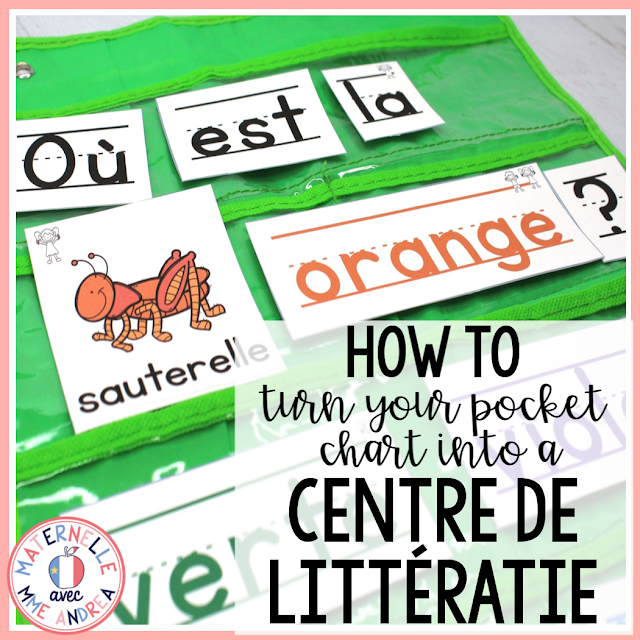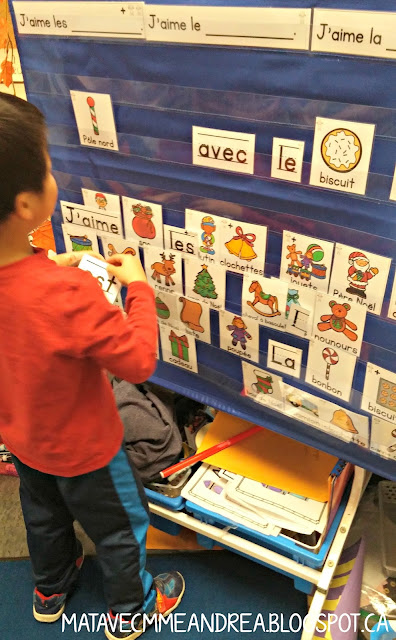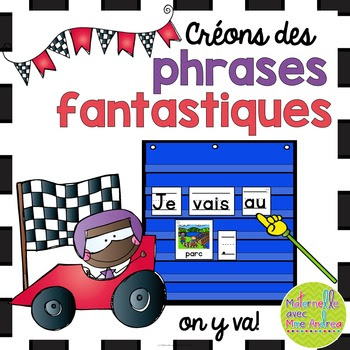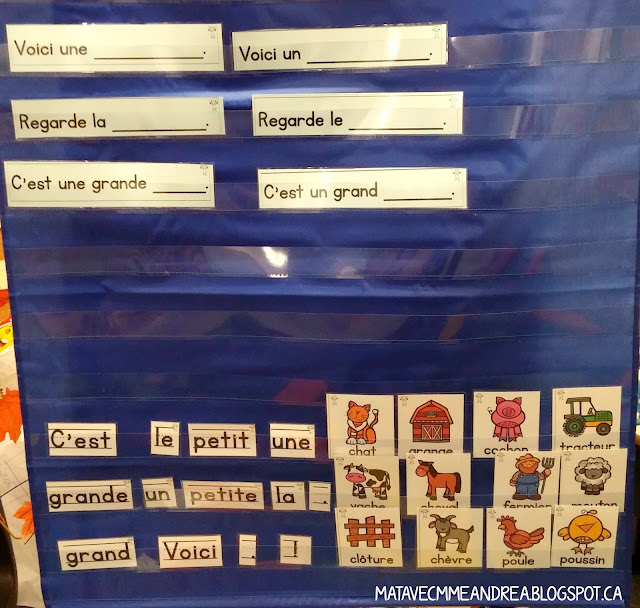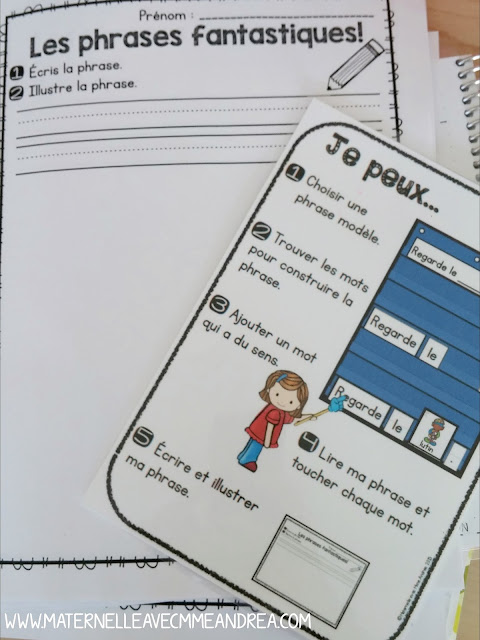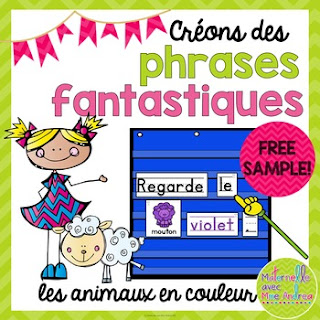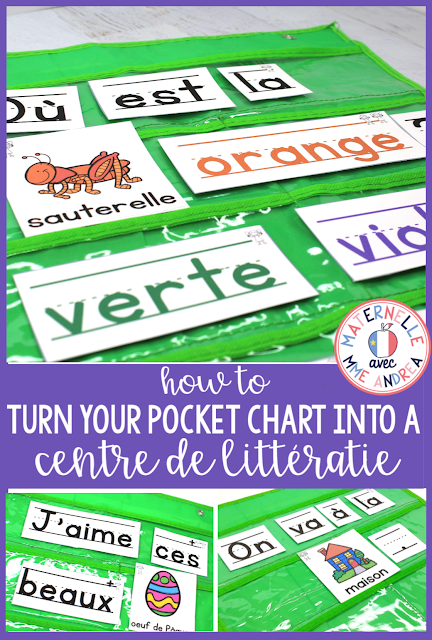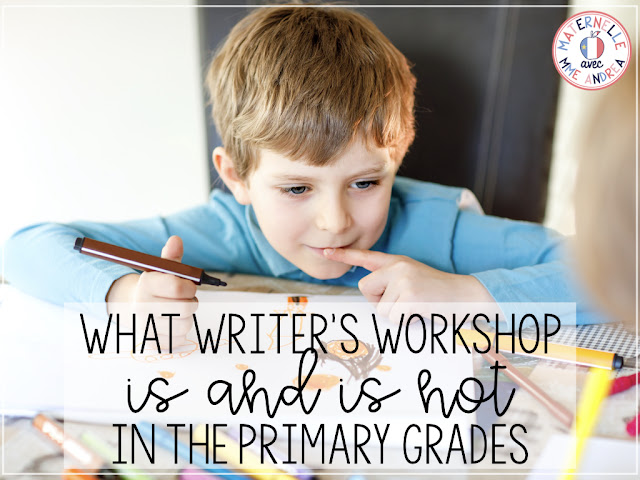Hey everyone!
In case you are late to the party, I have been sharing how I run literacy centres in my classroom over the past few weeks. You can find out how I start centres in this post, how I organize them over here, and see ALL of the centres I have posted about so far by clicking here.
Do you have a pocket chart in your classroom? Are you looking for ideas and/or ways to use it during your literacy centres?
Today’s post is for you!
I am writing all about how I use my pocket chart during centre time.
90% of the time, I use my pocket chart for what I like to call “Phrases fantastiques”. So, most of this post will be about those! At the end, I will share a couple of other ideas that you can incorporate with your pocket chart.
Phrases fantastiques are a great way to build your students’ vocabulary, work on their one-to-one correspondence, practice sight words, work on correct sentence structure in their second language, encourage them to start thinking about masculin vs. féminin, and get them reading and writing simple sentences en français. I am all about killing two birds with one stone, and being as efficient as possible, and this centre kills so many birds with just one resource!
Here is how to set it up and get started:
1. CHOOSE YOUR THEME
I like to use seasonal themes, because I like to practice seasonal vocabulary with my students as much as possible. Holidays and seasons are a huge part of their lives, and it makes sense for our students to be learning words that allow them to describe and discuss what is happening around them. I also have a few themes that are not seasonal, but are great for other common vocabulary words and/or sentence structures that I would like for my students to practice. For example, we are currently working on sentences using farm vocabulary, and will soon move into Christmas.
I don’t know about you, but sentence structure is a huge issue for my anglophone students. We have targeted as a school certain structures for each grade level that we want all of our students to master. I am sure that your students make similar errors – “Je suis fini!”, “Je va”, etc!
You can use predictable sentences in your pocket chart to get your students practicing correctly reading and writing these key sentence structures over and over. One of my favourite themes that we do is called On y va! – it practices “Nous allons” and “Je vais.”
We need a LOT of practice with those!!!
For the picture, I had put all of the sentences in the pocket chart, but in my classroom, I would only have one sentence at a time –
“Voici un ______/Voici une _______” OR
“Regarde le _______/Regarde la _______” OR
“C’est une grande ________/C’est un grand _______”
After practicing our sentence for a week or two and ensuring everyone has a turn at that centre, I might choose to switch themes all together, or keep the same vocabulary cards but change the phrases modèles and sight words. I LOVE Christmas, so I always milk that theme for at least a month, but the others I will usually rotate out after two weeks!
3. PRACTICE LOTS – WHOLE GROUP!
One thing about these sentences is that you really want to make sure that your students know how to read their sentences on their own. This centre should be a review of what they already know. We don’t want them copying sentences but having no idea what they say! It can also be a big challenge for our students to understand and pay attention to the gender of words in French – it is important to talk about it each time!
“Comment est-ce que tu savais de mettre la et non le? Pourquoi as-tu choisis le mot une et non un?” Get them to tell you out loud, in their own words! I always hang up a new theme and practice it as a class multiple times before adding it into our centre rotations. Then, I still review the vocabulary and sight words at least once a week with my class. A fun way to do this after reviewing all of the vocabulary is to ask a student to come up and select a phrase modèle and build it in front of the class. Then I let them choose a friend to read their sentence. They get to use my “baguette magique” to point to the words. That friend can choose another, etc. etc. After every couple students, I will switch out a vocabulary word or change the phrase modèle to try and “trick” them.
Each of my sets also includes two different mini books that practice the same sentences and vocabulary. You can print these out and have your students colour them during their centres or after introducing them to each new sentence. They are perfect to send home for additional practice!
I also have special writing paper for each theme. You can get your whole class to practice writing and illustrating their sentences before including that as part of their centre as well.
4. SHOW THEM HOW TO DO IT ON THEIR OWN
Once your kiddos have Phrases fantastiques down pat as a whole-class activity, show them how to do them on their own as a centre. I review this every time I change the phrases modèles and/or the theme, and once a week besides. When? During one of our five-minute discussions that we have before each centre rotation! I expect my students to take turns building sentences, and then choose their favourite centre and write it down on the provided paper. I then expect them to illustrate it – their best work and lots of details!
As pictured above, I include an “I Can” card in the centre bin. That way, they can refer to it if they forget what to do – instead of asking me or disturbing another group. I will often show great student work during our pre-centre discussion, and they know that I expect that caliber of work from everyone.
Of course, I forgot to take a picture of an example for you… but I will try to remember this week and come back and add to this post!
5. REVIEW, REVIEW, REVIEW!
I already said this above, but it is worth repeating. Review often!
Kindergarten students generally want to please, but they need loooooots of reminders and concrete examples of exactly what you want from them. If their behaviour is off during this centre, one of my favourite ways to remind them of my expectations is to build an anchor chart together. I make a T table on a piece of chart paper – one side for their jobs during the Phrases fantastiques centre, and one side for my jobs (help students in my group, set the timer, etc.). Then I ask them for examples to fill both sides of the chart. Their jobs include staying in one place, working for the whole time, doing their best work, building/writing/illustrating at least one sentence, working quietly, etc. We re-create the T table as many times as we need to throughout the year. For whatever reason, it works every time!
I actually have a free Phrases fantastiques sample in my FREE French Resource Library, if you are interested in giving this centre a try! It is another great one for sentence structure – Les animaux en couleur.
To access this freebie, just CLICK HERE, enter your info, and click the pink button. I’ll email you the password + access instructions right away!
If you are looking for other ideas for your pocket chart, my other two favourite things to do are poetry and sorts! You can cut up any poem that your students know (either cut each line apart or cut apart the words, depending on your students’ abilities) and get them to put the poem back together in the right order.
You can also do lots of sorts for science and social studies – needs vs. wants, living vs. non living things, healthy vs. unhealthy foods, etc. – or ask your students to come up with their own sorting rules for the vocabulary words you provide.
I hope this blog post helps you with your pocket chart centre! Do you currently use any of my Phrases fantastiques resources? Which theme is your favourite? Let me know in the comments below!


